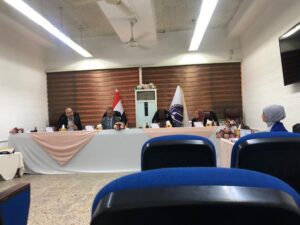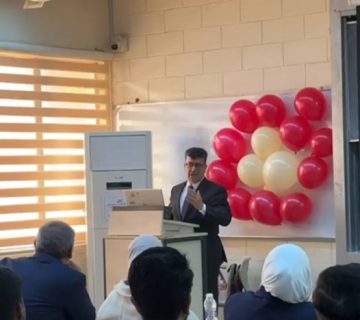Environmental Engineering Department at the College of Engineering, University of Baghdad, held MSc thesis examination on Sunday 4\5\2023 titled:
” An Experimental Study for the Removal of Ibuprofen from Aqueous Solution by using Green Synthesis of TiO2 and Fe NPs in Advanced Oxidation Process”
By the student Haneen Ali Abdulrazaq and supervised by Prof. Dr. Abeer Ibraheem Musa. The examination committee consisted of Prof. Dr. Ayad Abdulhamza Faisal as Chairman, and the membership of Professor Dr. Zainab Bahaa Mohammed, and Assist. Prof. Dr. Hayder Mohammed Abdulhameed. After conducting the public discussion and listening to the student’s defense, the thesis was accepted. It was summarized as follows:
Pharmaceuticals are recognized as category of environmental contaminants and are attracting significant study in terms of their environmental origin and toxicological effects. Antibiotics are among the most widely consumed compounds among pharmaceutical drugs such as Ibuprofen (IBU) is considered toxic and dangerous chemical. For this, IBU waste need to be treated before being disposed to the environment. In the present study the performance of degradation of antibiotic Ibuprofen in aqueous solutions has been studied to be removed by using advanced oxidation process in two systems: photo catalysis with biosynthesis titanium dioxide and homogeneous photo catalysis by photo-Fenton technique and using UV as irradiation source. Green synthesis TiO2 and iron nanoparticles were fabricated using Grape leaves extract and Pomegranate peels, and denoted as GL-TiO2 and Fe NPs-PP, respectively. The Obtained nanoparticles were well categorized by SEM, TEM, EDS, FT-IR, XRD, and BET. The influence different experimental parameters such as, GL-TiO2 (15, 30, and 60) mg/L, Fe NPs-PP (10, 20, 30, and 40)mg/L, pH (3, 5, 7, and 9), and initial concentration of IBU (10, 20, 40, and 80) mg/L and their relationship with the degradation efficiency were studied in batch mode for both techniques. The experimental results showed that the removal efficiencies were 92.32% and 94.25% at the best conditions of H2O2 of 300 mg/L, pH of 3, 10 mg/L IBU concentration, and 150 irradiation time for heterogeneous photocatalytic (GL-TiO2 of 30mg/L) and homogeneous photocatalytic process (Fe NPs-PP of 20mg/L), respectively. In addition, the results confirm that the kinetics of IBU degradation followed the pseudo-first-order model. The formation of several by products during the degradation of Ibuprofen was evaluated by the two processes. However, both methods are proven to be effective for Ibuprofen degradation. Finally, Photo- Fenton/AOPs treatment successfully show a positive influence in elimination of Ibuprofen more than heterogeneous process.










